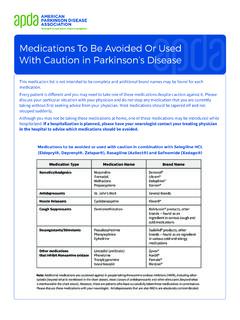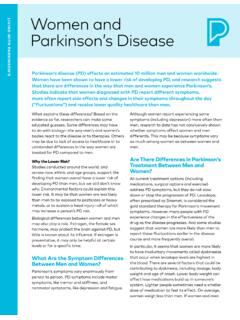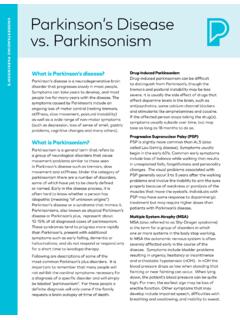Transcription of Parkinson’s Disease
1 parkinson s DiseaseHANDBOOKCONTRIBUTORSG rateful appreciation to the following who contributed to the writing of the parkinson s Disease Handbook:David G. Standaert, MD, PhDJohn N. Whitaker Professor and Chair of NeurologyUniversity of Alabama at Birmingham, School of MedicineChair, APDA Scientific Advisory BoardMarie H l ne Saint-Hilaire, MD, FRCP(C)Professor of NeurologyBoston University School of MedicineMedical Director, parkinson s Disease and Movement Disorders Center, Boston University Medical Campus, APDA Advanced Center of ResearchCathi A. Thomas, RN, MS, CNRNA ssistant Clinical Professor of NeurologyProgram Director, parkinson s Disease and Movement Disorders Center, Boston University Medical CampusCoordinator, American parkinson Disease Association Information & Referral Center at BUMCJoan and Ross CollardRevised by Dr.
2 Rebecca Gilbert, Vice President and Chief Scientific Officer, APDA, 2019 The information contained in this booklet is solely for the information of the reader. It should not be used for treatment purposes, but rather for discussion with the patient s own of ContentsA Letter to the Reader ..1 Strength in Optimism. Hope in Progress..3 What Is parkinson s Disease ? ..4 How PD Affects the BrainTheories About CauseSymptoms ..8 Motor and Related Symptoms of PDNon-Motor Symptoms of PDDiagnosis ..15 What to Expect at the First Physician VisitTools to Aid DiagnosisThe Healthcare Provider TeamIf It s Not Idiopathic PD, What Could It Be?Treatments ..20 Daily LivingMedications for the Motor Symptoms of PDA Word About Motor ComplicationsSurgeryAlternative/Compleme ntary Therapies for Motor SymptomsTreatments for Non-Motor Symptoms of PDMedications Approved for Non-Motor Symptoms of PDResearch and Resources.
3 35 Caring for Those With PDLiving to Your Fullest PotentialGlossary .. LETTER TO THE READERThe American parkinson Disease Association (APDA) is here to provide you with the necessary information and resources to better manage parkinson s Disease (PD). If you or someone close to you has been diagnosed with PD, you may feel overwhelmed. This handbook has been designed to help by providing valuable information about PD, including common symptoms, available treatments for Disease management, practical tips on caring for someone with PD, and research currently underway in PD. In addition, resources that may be of help to you are provided at the end of this you read through this handbook, keep in mind that PD affects each person differently, so don t worry if you come across information that does not apply to you or your loved one s current situation.
4 This handbook is intended to provide information for all of those affected by dealing with PD, your partnership with your neurologist is extremely valuable. It is important to consult with a qualified physician you trust about the course of PD management that is best for you. The information in this handbook should better prepare you to talk to your physician and the additional healthcare providers with whom you will work. Managing any challenge is easier when working with a team, and PD is no exception. Ideally, you will be collaborating with a group of healthcare professionals with expertise in PD to better manage your care. This handbook will introduce you to many of the possible members of your healthcare personal support team is also extremely valuable when living with PD.
5 Maintaining your current networks of support (family, friends, groups you belong to) is crucial but also consider branching out to find others who can support your care. This handbook will provide information about resources and support services that are available to help you remain active and maintain important social connections as well as build new s Disease HandbookAt APDA, every day, we provide the support, education, and research that will help everyone impacted by PD live life to the fullest. To accomplish this, APDA funds important research and provides education and support to individuals living with PD, their family members, and the community at large. In addition to reading this handbook, visit APDA s website at for more information and also consider contacting an APDA Information & Referral Coordinator who provides services in your community.
6 APDA is here to help you take a more active role in the successful management of PD. As President and CEO of APDA, I want to welcome you to the Association and its many resources. The American parkinson Disease Association wants you to look to the future with hope and ,Leslie A. Chambers President and CEO American parkinson Disease IN OPTIMISM. HOPE IN PROGRESS. The American parkinson Disease Association (APDA) is the largest grassroots network dedicated to fighting parkinson s Disease (PD) and works tirelessly to assist approximately 1 million Americans with PD live life to the fullest in the face of this chronic, neurological disorder. Founded in 1961, APDA has raised and invested more than $185 million to provide outstanding patient services and educational programs, elevate public awareness about the Disease , and support research designed to unlock the mysteries of PD and ultimately put an end to this Disease .
7 To join us in the fight against parkinson s Disease and to learn more about the support APDA provides nationally through our network of Chapters and Information & Referral (I&R) Centers, as well as our national Research Program and Centers for Advanced Research, please visit us at | Every day, we provide the support, education, and research that will help everyone impacted by parkinson s Disease live life to the s Disease HandbookWHAT IS parkinson S Disease ?So what exactly is parkinson s Disease (PD)? PD is a type of movement disorder* that can affect the ability to perform common, daily activities. Although PD is associated with a wide range of symptoms, there are features of PD that most people with the condition will experience.
8 These symptoms are typically divided into those that affect movement (motor symptoms) and those that do not (non-motor symptoms).The most common motor symptoms of PD are tremor (a form of rhythmic shaking), stiffness or rigidity of the muscles, and slowness of movement (called bradykinesia). A person with PD may also have trouble with posture, balance, coordination, and walking. Common non-motor symptoms of PD include sleep problems, constipation, anxiety, depression, and fatigue, among others. You will learn about the motor and non-motor symptoms of PD in greater detail in the next is important to note that, although there are common symptoms of PD, they can vary greatly from person to person.
9 Moreover, how these symptoms change over time and whether other symptoms of PD emerge differ from person to person. Most people who develop the symptoms of PD do so sometime after the age of 50, but PD can affect younger persons as well. There are an estimated 1 million Americans living with PD and more than 10 million people worldwide.*Note: Bolded terms are defined in the glossary at the back of this booklet Chapter PD Affects the BrainPD is a neurodegenerative Disease . There is a loss of neurons (nerve cells) in certain areas of the brain, including a region called the substantia nigra (sub-STAN-she-uh NYE-gruh), Latin for black substance. The neurons in this region (which appear dark under a microscope) produce a neurotransmitter (a chemical messenger that allows neurons to communicate) called dopamine.
10 Dopamine helps to regulate movement. As the number of cells in the substantia nigra decreases, there is less dopamine available in the brain. Dopamine is important to maintain normal movement patterns. This loss of dopamine is the reason that many treatments for PD are intended to increase dopamine levels in the brain. Treatment for PD will be explained in more detail in Chapter 4. Loss of neurons in other parts of the brain also occurs in PD, and accounts for some of the non-motor symptoms of the addition to decreases in dopamine and the cells that make dopamine, you might also read or hear about a protein called alpha-synuclein (AL-fa-sin-NUKE-lee-un). Studies suggest that alpha-synuclein normally helps neurons communicate with each other.





